Communities in Bohol have drawn inspiration from their history and cultural heritage to develop creative hubs designed to promote sustainable tourism, create livelihood and help local residents recover from the 2013 earthquake.
The towns of Loon, Maribojoc, Antequera and Baclayon were scenes of devastation after a 7.2 intensity quake struck the island province in the morning of Oct. 15 four years ago, destroying roads, bridges and houses, and leaving centuries-old churches in ruin. More than 200 people lost their lives in the disaster.
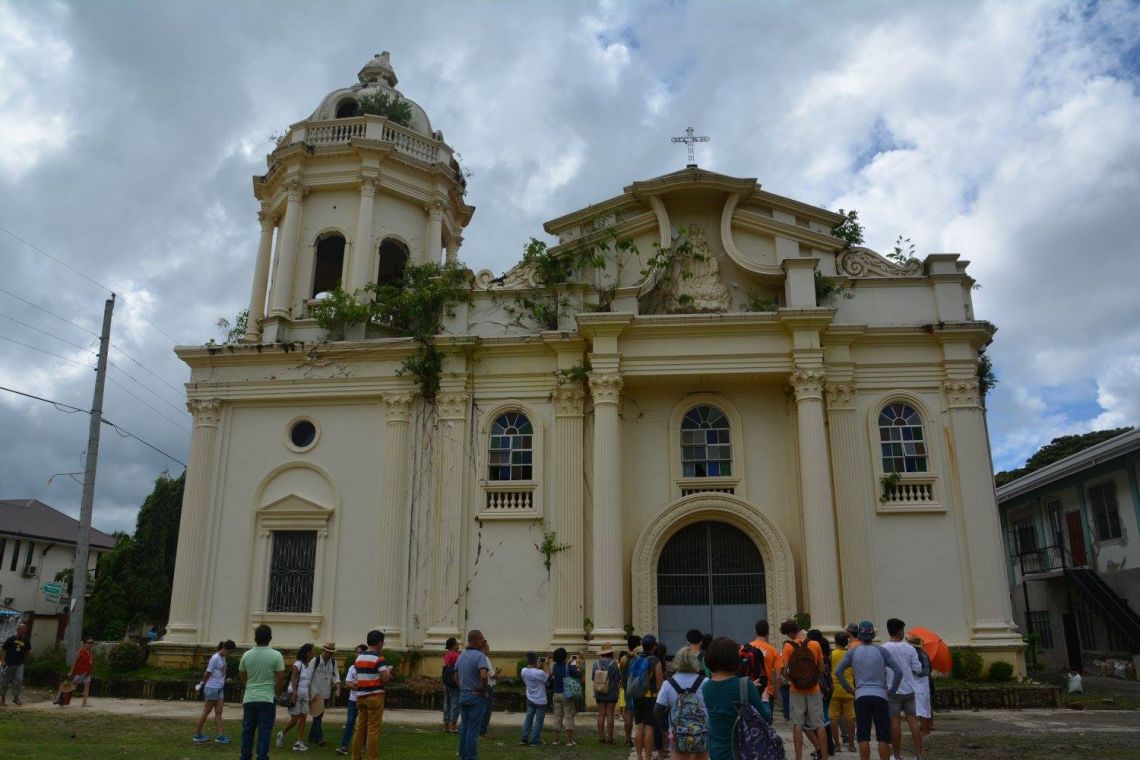
Antequera church facade with plants growing on cracks resulting from the 2013 earthquake. (Photo by Roy Llanes)
By the 3rd quarter of 2017, these towns, along with three others (Cortes, Balilihan, and Tagbilaran), were throbbing with cultural activity as the initial test run of the heritage-based creative hubs was underway. This drew raves from guests owing to their uniqueness, passion-filled delivery and authenticity.
The test runs concluded a series of arts-based workshops, heritage camp, lectures, and planning sessions held during the first year of the Bol-anong Kabilin, Atong Gibahandi (BOKAG) program involving cultural workers, artists, tourism officers, educators, youth, and adult leaders from seven Bohol towns.
The various activities aimed to help participants rediscover and use their talents and heritage in designing their own creative hubs, said Lutgardo Labad, BOKAG art director.
BOKAG is a two-year program administered by PROCESS BOHOL, with artistic guidance from Kasing Sining, and support from the National Commission for Culture and the Arts (NCCA), the Bohol provincial government, and local governments of the seven participating towns. PROCESS is the Participatory Research, Organization of Communities and Education towards Struggle for Self-Reliance in Bohol.
Derived from the open indigenous woven basket used for storing and exchanging of farm products in Bohol, “bokag” symbolizes the islanders’ sturdiness, resourcefulness, craftsmanship and resilience, according to Emmie Roslinda, PROCESS executive director. The BOKAG program is part of efforts to find an inclusive development approach that is heritage and community-based which draws the benefits of tourism to the communities, thus sustaining recovery, she added.
Through fun games that made community stakeholders identify unique sites, history, food, dances, beliefs, and crafts in their municipality, the participants came up with a cultural and natural heritage map that became the basis of the design of a hub that reflected the special character of each town.
From such workshops, they were introduced to “the significance and range of local culture heritage as basis for the development of a viable creative industry” in their area, Labad further said.
Cultural historian Marianito Luspo stressed that each town’s history is unique and reflective of Bohol’s glorious past and is an important component in designing and planning heritage-based creative hubs.
Within the 3rd quarter of 2017, each BOKAG cultural team from the towns of Loon, Maribojoc, Antequera, Baclayon, Cortes, Balilihan and Tagbilaran piloted a creative hub unique to the cultural experience of the area.
Antequera town’s “Tan-aw sa Kanhiay, Lantaw sa Kinaiyahan” (Viewing Tradition, Experiencing Nature) cultural hub presented what it called “nature and babaylanic tourism,” one that focuses on nature healing, wellness and organic products.
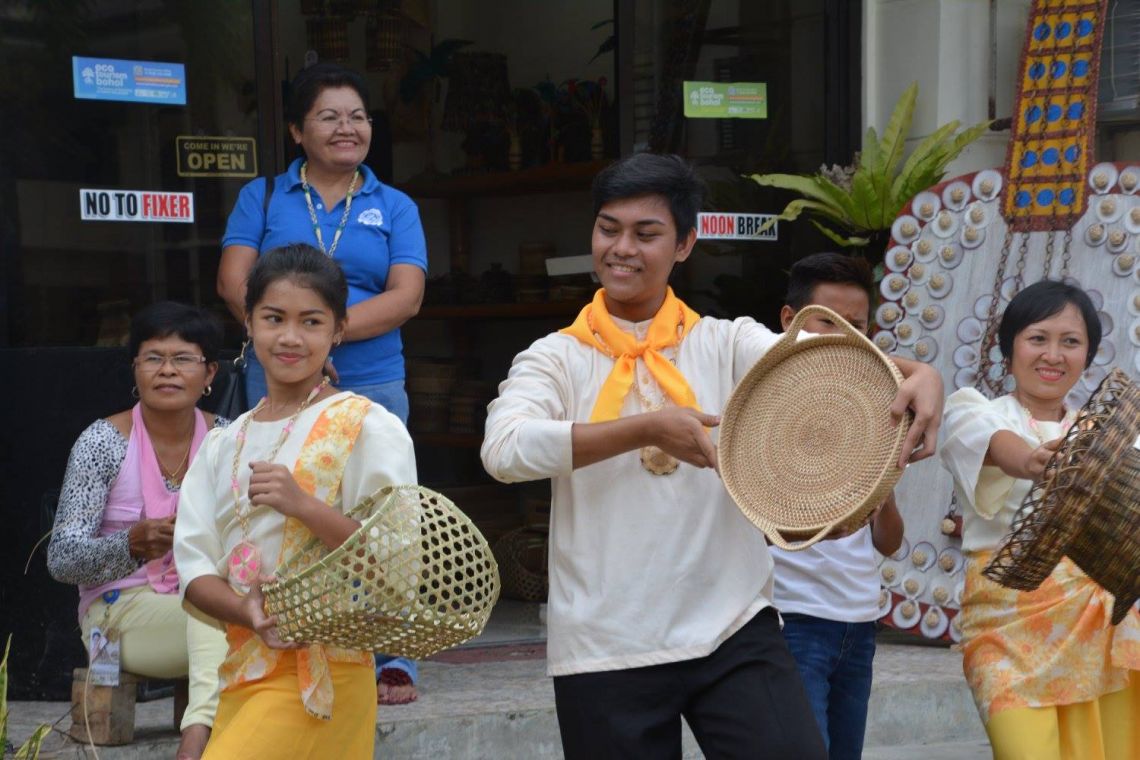
Antequera hub shows its baskets through a dance. (Photo by Roy Llanes)
First, the hub showed the various weaves used in basketry the town is famous for — through dance and in actual demonstration. It then led visitors to the Inambacan Waterfall/Cave and made them “feel” the cool environment through its greenery and the lively singing of the Antequera Cultural Collective.
Some visitors experienced natural healing and wellness practices, like the traditional massage passed on by the local hero Tamblot, a medicine man (babaylan) adept in the use of healing herbs.
“We want to highlight Tamblot society’s healing, wellness features and in the process share the way of life of the historic leader, and encourage descendants and visitors to adopt a sustainable, healthy, and calming lifestyle,” Antequera tourism officer Lorna Cabrisante Jadulco explained.
Maribojoc’s farm-based cultural hub, “Sandurot sa Kaumahan” (Fellowship in the Farm) in barangay Busao gave tribute to the farmers by making visitors experience life in a traditional rice farming village.
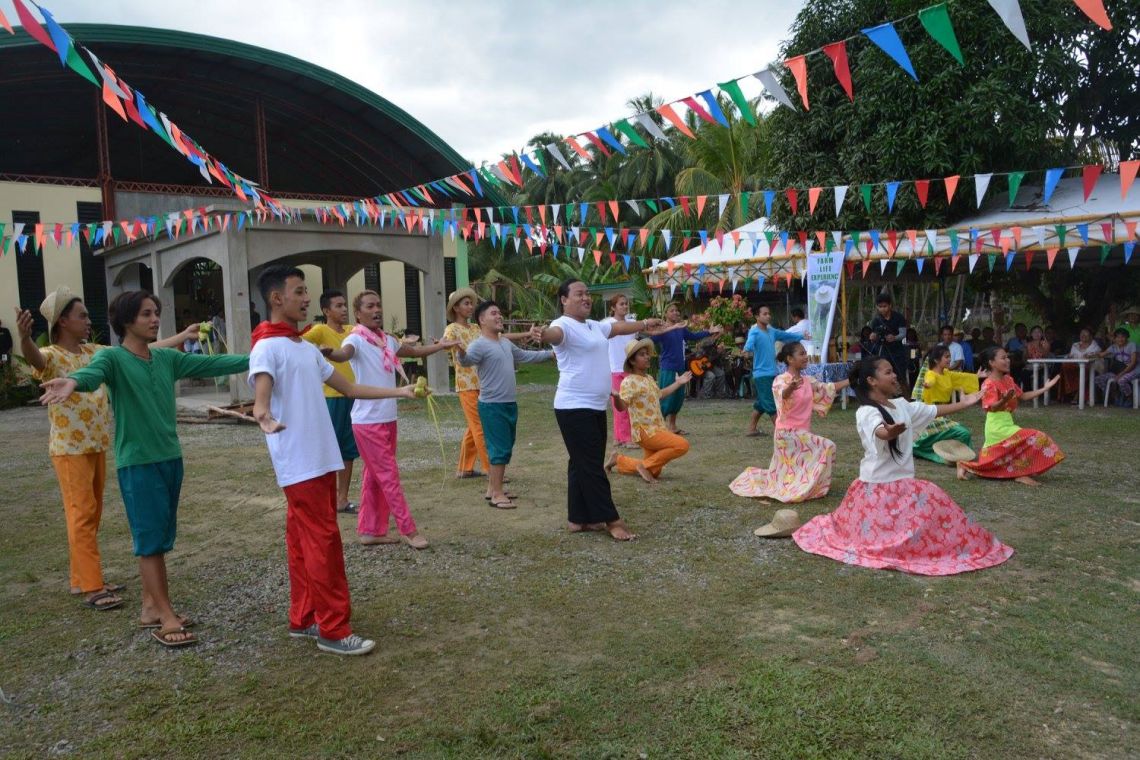
Welcome dance at Maribojoc’s farm-based hub. (Photo by Roy Llanes)
Guests were shown ancestral ways of processing rice grain before it is cooked and served on the table: from pounding in a pestle, winnowing and “alig-ig” (separation of unpounded rice). Others patiently tried to learn the making of the “puso” (woven palm rice container), while some watched how nipa is attached to a bamboo for use as roofing.
The creative products area displayed banana and cassava chips, and products of students of heritage restoration Escuela Taller, like carved wood and stone, and other organic-based crafts and décor.
Various cultural groups from Maribojoc then presented traditional songs and dances, like curacha mayor and “kulijit,” accompanied by a six-man rondalla. A “basaw” beat using a bamboo instrument concluded the hub’s activities as a way of thanking the village and farmers’ patron San Isidro Labrador.
Loon’s hub “Tikang sa Pagmugna” (Stairway to Creativity) provided visitors with an experience of the lively performance traditions of Loon and the town’s high regard for creativity, artistry and resilience.
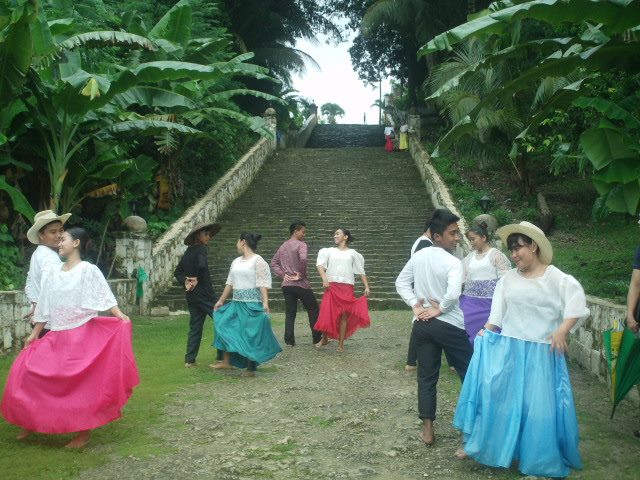
Youth dance on the Inang angan or Heritage Stairway in Loon Cultural Hub. (Photo by Cooper Resabal)
Visitors took part in a tour of a unique plaza and the ruins of the Church of Our Lady of Light. They then went on a coastal journey through a 212-step stairway that led guests to local theater, poetry, painting and dance lessons, and a burst of wild dancing of kuradang!
After joining the kuradang dancers, the visitors went to the “uplifted shores” of Napo village and were met there by the local fisherfolks who demonstrated how they fix their nets, and later sang along with guests some local ditties.
The 2013 earthquake raised the shores of Napo by 1.5 meters and dried up a large portion of the coastal area where corals and shellfish used to abound, reducing the area for shellfish gathering, a supplemental income source for the community.
Baclayon’s” Karaang Balay ug Tabo sa Baluarte” (Ancestral House and Market at the Lighthouse) hub opened with a harana and a musical treat from child-musicians at the Malon ancestral house followed with a snack of sikwate (chocolate drink) and broas, and other delicacies.
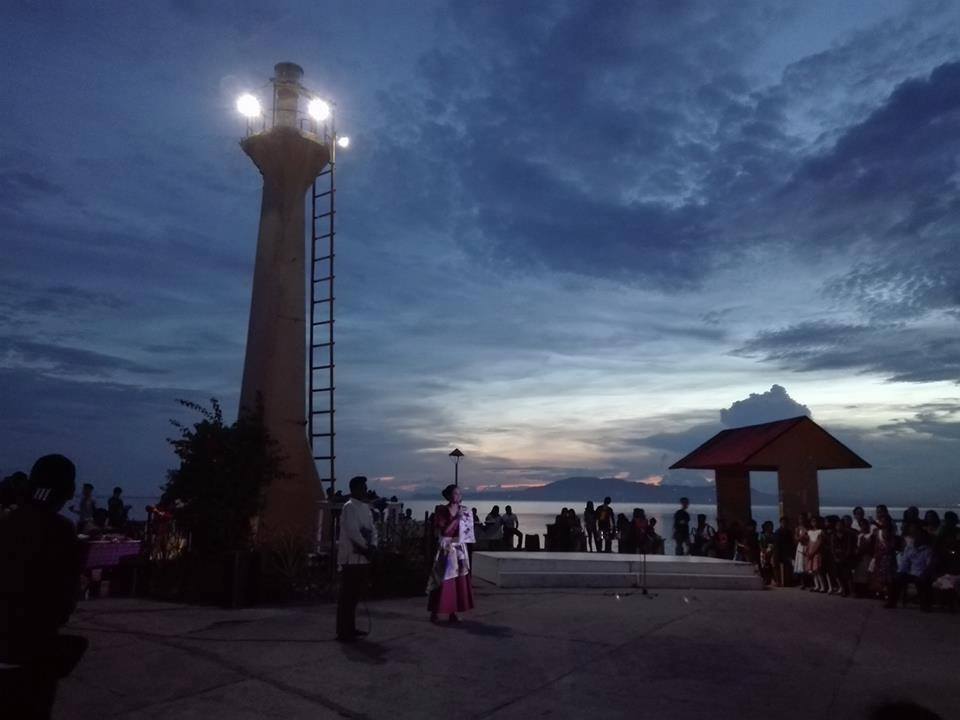
At the Baclayon town hub’s baluarte. (Photo by Jerrey Aguilar)
A short performance of the “Rico-Rico” tradition of Baclayon started with a singing of the traditional daygon (carol) at the foot of the staircase of the well preserved karaang balay (ancestral house), followed by the “angry” retort of the “tagbalay nga palaran” (wealthy house-owner).
Visitors were then led to the Baluarte where they saw a display of the residents’ livelihood in a traditional market that ended in a culinary and audio-visual feast, and vigorous dancing of kuradang.
Cortes’ hub “Tabo sa Cortes: Kabilin ni Wadji” (Cortes Market: Wadji’s Heritage) showcased an Asian-inspired semi-floating market where the traditional barter of goods and products was demonstrated, and actual sale of products carried out.
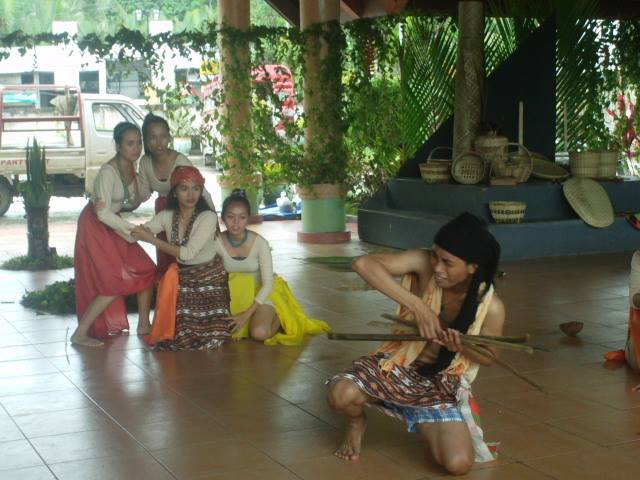
A scene in Cortes hubs play narrative on Wadji. (Photo by Cooper Resabal)
The site could become a future venue for fisher folks to sell their produce, and could enhance the promotion of local goods, like baskets, mats, fruits and marine and riverine products, Cortes’ Cultural Committee head explained.
The visitors then got into sampans, met and talked with a nipa leaf gatherer, a crab-catcher, a fisherman and a shellfish and clam gatherer while moving along Abatan River.
This is where they “witnessed” a costumed Wadji and some warriors releasing arrows on their bows pursuing raiders on another boat along the river. Upon arrival at the port, a group of women welcomed the visitors with a shower of flower petals.
The Cortes youth then presented a magic-realist narration of the pre-Hispanic leader Wadji’s story in the form of dance and martial arts movements accompanied by indigenous music/sound showing her as a symbol of leadership, particularly of women power.
In the audience were 22nd generation descendants of Wadji, Dutch nationals, tour guides, bloggers and some government officials. The audience and cultural workers then partook of seafood, fruits and other natural food in the time of Wadji, like coconuts, camote, rice cakes, bananas, etc.
Balilihan’s hub “Asoy sa Pagbangon” (Rising from the Ashes Story) portrayed the historical development of Balilihan from its original barter trading by the river, through the double crises of forced migration and colonial invasion resulting in the tragic burning of the entire town, climaxing to its rise from the ashes with the re-establishment of a vibrant town reflected in local industries.
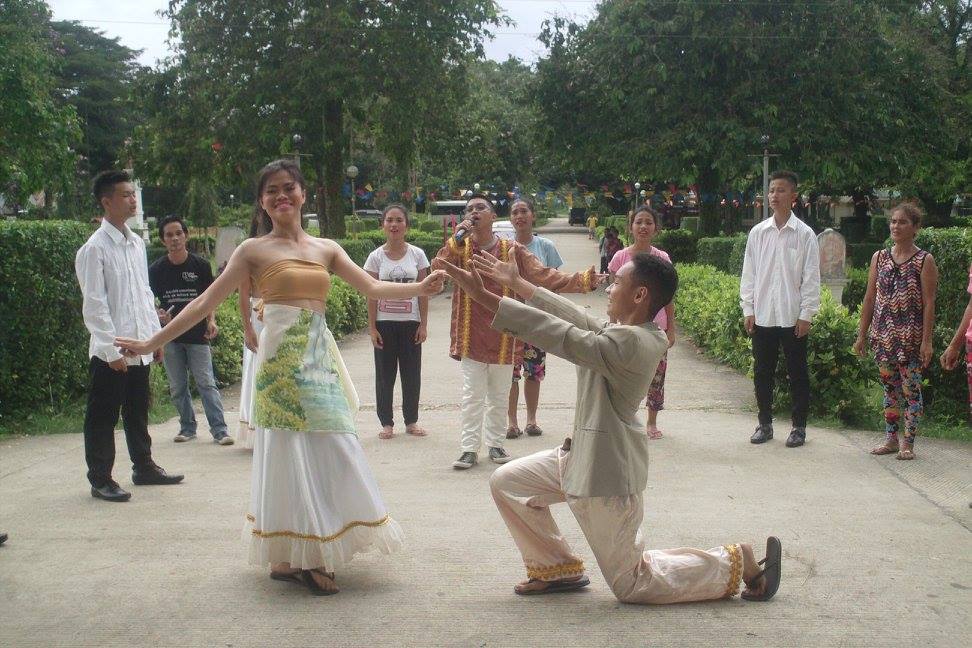
Rise of Balilihan town depicted in dance. (Photo by Cooper Resabal)
The hub took visitors to a pre-Hispanic spring near the park where diwatas (fairies) mingled with mortals, like lavanderas and farmers, who engaged in barter trade, then to a stage in the nearby plaza representing a place where residents experienced pain and healing– the “balay sa iring.”
The Balilihan youth gave a spirited re-enactment of the destruction of the town by American forces in 1900, and the march to development that followed, which was expressed through a dance interpretation of the Balilihan hymn. Guests were later escorted to the heritage church to view the famous paintings on its ceiling.
Balilihan Mayor Pureza Chatto then led visitors to partake of the town’s delicacies at the Hardin sa Balilihan Cafe where local products, like squash noodles, cassava chips and various crafts in nito vine were on display.
Tagbilaran’s pilot hub, “Balik sa Kagahapon” (Blast from the Past) made visitors experience a historical journey with the Tagbilaranons as they were taken to heritage sites from the Spanish colonial era, the American years, the Japanese occupation during World War II through a guided tour of historic houses and structures, combined with tableaus of events that took place in some heritage structures.
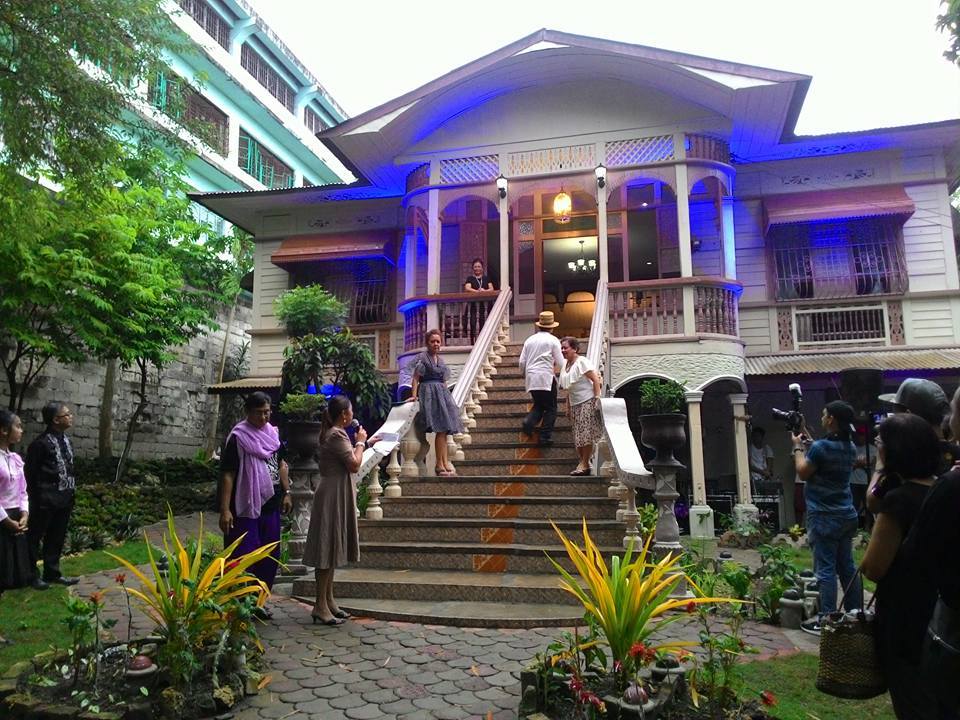
Balili heritage ancestral mansion in Tagbilaran’s cultural hub. (Photo by Shobel Lofranco)
They were then treated to a tertulia, a series of traditional Boholano cultural traditions, like balitaw and harana, choir and rondalla music, followed by dances at the Balili Heritage Mansion.
The seven cultural hubs soft-launched over the past several months are only previews of the final creative centers whose end goal is “to provide venues for community solidarity, protection of heritage, enhancing creativity and livelihoods among the communities, and effect sustained recovery,” explained Labad.